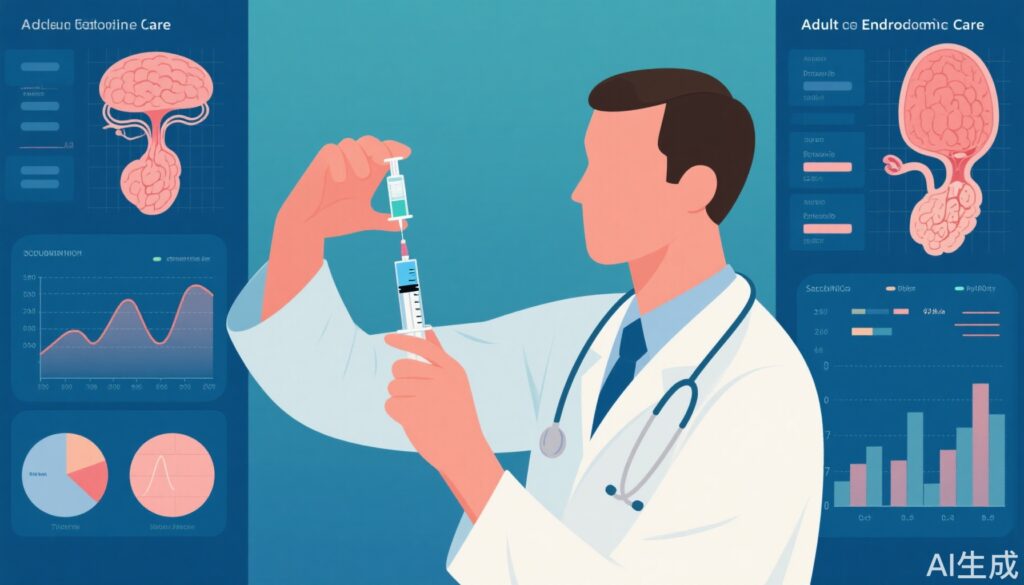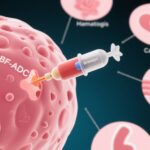Highlight
– The FDA has approved lonapegsomatropin-tcgd (Skytrofa) for adults with growth hormone deficiency (GHD), expanding its original pediatric indication.
– In the phase 3 foresiGHt trial, once-weekly lonapegsomatropin was superior to placebo and comparable to daily somatropin in improving body composition, with similar safety outcomes.
– Skytrofa’s weekly regimen addresses a significant unmet need for treatment convenience and may enhance adherence among adult GHD patients.
– The approval is expected to influence clinical practice and prompt updates to adult GHD management guidelines.
Background
Adult growth hormone deficiency (GHD) is a rare but impactful disorder resulting from insufficient production of growth hormone (GH) due to pituitary or hypothalamic dysfunction. Unlike pediatric GHD, which primarily manifests as short stature, adult GHD is associated with abnormal body composition (increased fat mass, reduced muscle mass), dyslipidemia, decreased bone mineral density, impaired quality of life, and increased cardiovascular risk [1,2].
Current standard therapy involves daily subcutaneous injections of recombinant human GH (somatropin), which can be burdensome and negatively impact long-term adherence. Poor adherence is associated with suboptimal clinical outcomes, including persistent metabolic and psychological complications [3]. Consequently, there is a pressing clinical need for effective, less burdensome treatment options.
Study Overview and Methodological Design
The FDA’s approval of lonapegsomatropin-tcgd (Skytrofa) for adults with GHD was based on the pivotal phase 3 foresiGHt trial (NCT03831880). This double-blind, randomized controlled trial enrolled 259 adults diagnosed with GHD, randomized 1:1:1 to receive weekly lonapegsomatropin, daily somatropin, or weekly placebo for 38 weeks.
Key inclusion criteria included adults (≥18 years) with confirmed diagnosis of GHD according to standardized stimulation testing and exclusion of patients with active malignancy, uncontrolled diabetes, or proliferative retinopathy. The primary endpoint was change from baseline (CFB) in trunk fat percentage, as measured by dual-energy X-ray absorptiometry (DEXA). The main secondary endpoint was CFB in total lean body mass. Safety and tolerability were systematically assessed throughout the trial.
Key Findings
Lonapegsomatropin demonstrated clear efficacy over placebo and was non-inferior to daily somatropin, with significant improvements in several clinically relevant endpoints:
– **Primary Endpoint:** At 38 weeks, lonapegsomatropin led to a greater reduction in trunk fat percentage compared to placebo (P<0.0001).
– **Secondary Endpoint:** Increases in total lean body mass were significant versus placebo (P<0.0001) and comparable to daily somatropin.
– Other secondary measures (e.g., total body fat, lipid profiles) showed consistent trends in favor of lonapegsomatropin over placebo.
– **Safety:** Severe adverse events were infrequent and comparable across groups (lonapegsomatropin 3.4%, placebo 1.2%, somatropin 2.3%). The incidence of treatment-related adverse events was similar between lonapegsomatropin and daily somatropin (24.7% vs. 22.1%). The most common side effects were peripheral edema and mild hypothyroidism, consistent with known GH therapy profiles.
Mechanistic Insights and Pathophysiological Context
Lonapegsomatropin is a prodrug of somatropin, engineered for sustained release through reversible PEGylation. Upon subcutaneous injection, the prodrug is gradually cleaved to release unmodified, bioactive somatropin, closely mimicking endogenous GH secretion patterns [4]. This pharmacokinetic profile underpins the rationale for once-weekly dosing and is expected to offer stable IGF-1 levels, minimizing peaks and troughs associated with daily injections.
GH replacement in adults corrects body composition by promoting lipolysis, increasing muscle protein synthesis, improving bone metabolism, and favorably modulating cardiovascular risk factors. Restoring GH levels also has positive effects on psychological well-being and cognitive function [5].
Clinical Implications
The once-weekly regimen of Skytrofa represents a substantial advance in GHD management. For clinicians, this simplifies the prescription and monitoring process and may particularly benefit patients with adherence challenges, needle aversion, or busy lifestyles. Improved ease of administration could translate into better long-term outcomes by increasing sustained therapy uptake.
Patient selection remains critical: GH therapy should be individualized, with careful titration to normalize IGF-1 while monitoring for adverse effects. Skytrofa’s efficacy and safety profile align with existing GH products, but its unique dosing schedule fills a key gap in therapeutic convenience.
Insurance coverage, cost considerations, and patient preference (including device-related factors) will influence uptake. As the clinical experience with Skytrofa in adults grows, real-world data will help refine its role relative to daily GH formulations.
Limitations and Controversies
Despite robust trial methodology, several limitations merit discussion:
– The foresiGHt trial excluded individuals with certain comorbidities (e.g., active malignancy, uncontrolled diabetes), potentially limiting generalizability.
– The trial duration (38 weeks) is relatively short for assessing long-term cardiovascular and fracture outcomes.
– Head-to-head data with other long-acting GH formulations (e.g., somapacitan) are lacking.
– The impact of weekly dosing on health-related quality of life, adherence, and cost-effectiveness in real-world practice remains to be fully elucidated.
Some endocrinologists have raised questions regarding the potential for PEG accumulation (due to the prodrug design), but current evidence suggests no clinically significant safety concerns with lonapegsomatropin [4].
Expert Commentary or Guideline Positioning
Dr. Kevin Yuen, a leading authority on pituitary disorders, emphasized that adult GHD impairs not only metabolic health but also emotional and cognitive well-being. He noted, “It is no surprise that patients are looking for a less burdensome treatment regimen, and a new treatment option.”
Current Endocrine Society guidelines endorse GH replacement for adults with confirmed GHD, titrated to maintain age-adjusted IGF-1 levels [5]. The introduction of long-acting GH analogs is expected to prompt updates in future guideline iterations, with a focus on individualized therapy and shared decision-making.
Conclusion
The FDA’s approval of once-weekly lonapegsomatropin-tcgd (Skytrofa) for adults with GHD represents a major step forward in endocrine therapeutics. By reducing injection burden and maintaining efficacy and safety, Skytrofa addresses a core barrier to optimal long-term management. Ongoing surveillance and real-world studies will clarify its place in therapy, particularly regarding adherence, quality of life, and long-term outcomes.
References
1. Molitch ME, Clemmons DR, Malozowski S, et al. Evaluation and Treatment of Adult Growth Hormone Deficiency: An Endocrine Society Clinical Practice Guideline. J Clin Endocrinol Metab. 2011;96(6):1587-1609.
2. Yuen KCJ, Biller BMK, Radovick S, et al. American Association of Clinical Endocrinologists and American College of Endocrinology Guidelines for Management of Growth Hormone Deficiency in Adults and Patients Transitioning from Pediatric to Adult Care. Endocr Pract. 2019;25(11):1191-1232.
3. van Bunderen CC, van Nieuwpoort IC, Drent ML. Effects of growth hormone therapy in adults with growth hormone deficiency: a systematic review. Eur J Endocrinol. 2014;170(6):R1-R13.
4. Johannsson G, Feld S, Højlund K, et al. Once-weekly somapacitan is effective and well tolerated in adults with GH deficiency: a randomized phase 3 trial. J Clin Endocrinol Metab. 2020;105(4):e1358-e1370.
5. Cook DM, Yuen KCJ, Biller BMK, et al. American Association of Clinical Endocrinologists Medical Guidelines for Clinical Practice for Growth Hormone Use in Adults and Children—2009 Update. Endocr Pract. 2009;15(Suppl 2):1-29.



